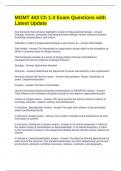MGMT 443 Ch 1-3 Exam Questions with
Latest Update
Five elements that compose Galbraith's model of Organizational Design - Answer-
Strategy, structure, processes (including decision-making), human resources policies
(including compensation), and culture
Galbraith's model of organizational design is also known as - Answer-Start Model
Start Model - Answer-The framework for organization design which is the foundation on
which a company bases its design choices
The framework consists of a series of design policies that are controllable by
management and can influence employee behavior
Strategy - Answer-Determines direction
Structure - Answer-Determines the placement of power and authority in the organization
Structure policies fall into four areas - Answer-Specialization, Shape, Distribution of
power, Departmentalization
Process - Answer-The flow of information
Human resources policies (including compensation) or REWARDS means - Answer-
They influence the motivation of people to perform and address organizational goals
Culture or People means - Answer-This area governs the human resource policies of
recruiting, selection, rotation, training, and development
In Structure, Specialization means - Answer-The type and numbers of job specialties
used in performing the job
In Structure, Shape means - Answer-The number of people in the departments at each
level (span of control)
In Structure, Distribution of power means - Answer-In its vertical dimension, it refers to
the classic issues of centralization or decentralization. In its lateral dimension, it refers
to the movement of power to the department dealing directly with the issues critical to its
mission
In Structure, Departmentalization means - Answer-The basis for forming departments at
each level of the structure. The standard dimensions on which departments are formed
are functions, products, workflow processes, markets, customers, and geography.
, Matrix structures are ones where two or more dimensions report to the same leader at
the same level
Structural dimensions - Answer-Centralization, Formalization, Specialization, Hierarchy
of authority (span of control), Vertical, and Horizontal complexity
In Structural dimensions, Centralization - Answer-Refers to the level of hierarchy with
authority to make decisions
In Structural dimensions, Formalization - Answer-The degree to which an organization
has rules, procedures,and written documentation
In Structural dimensions, Specialization - Answer-The degree to which tasks are divided
into separate, specialized jobs
In Structural dimensions, the Hierarchy of authority (span of control) - Answer-Who
reports to whom? The number of people reporting to a supervisor
In Structural dimensions, Vertical complexity - Answer-Number of levels in the hierarchy
In Structural dimensions, Horizontal complexity - Answer-Number or distinct department
in the organization
Contingency factors - Answer-Culture, size, goals and strategy, environment, and
technology
In Contingency factors, Culture is - Answer-The set of values, norms, guiding beliefs,
and understandings that are shared by members of an organization and taught to new
members as the correct way to think, feel, and behave
In Contingency factors, Size means - Answer-It can be measured for the organization
as a whole or for the specific components. Normally the number of employees
In Contingency factors, Goals is - Answer-A desired state of affairs that the organization
attempts to reach
In Contingency factors, Strategy means - Answer-A plan for interacting with the
competitive environment to achieve organizational goals
In Contingency factors, Environment means - Answer-Includes all elements outside the
boundary of the organization. Key elements are the industry, government, customers,
suppliers, and the financial community. Typically other organizations or competitors
In Contingency factors, Technology means - Answer-The work processes, techniques,
machines, and actions used to transform organizational inputs (materials, information,
ideas) into outputs (products and services)




